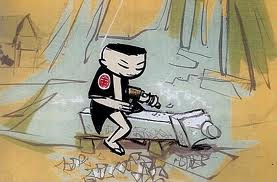Oddball Films Media
•
Jan 12, 2014
Picturesque Japan (Color, 1951)
During World War II, works analyzing and deconstructing Japanese culture came into demand due to a perceived need to “know your enemy” by the American government. The U.S. occupied Japan from the end of the war until 1952, during which time such texts gained popularity with a mass audience, informing a popular understanding of Japan. Some foundational claims from such studies remain instilled in the rhetoric surrounding Japanese culture. Specifically, the claim that Japan is constructed around a series of contradictions remains prevalent; that Japan is at the center of the clash between “modern” and “traditional” cultures, and contemporary culture emerges from a constant negotiation between the two. This position is featured prominently in Picturesque Japan, as both modern shopping malls and pearl diving communities are juxtaposed in order to explain post-war Japanese culture.
Tara the Stonecutter (1955, color)
Image

The Colonel Comes To Japan (Color, 1984)
This Emmy-winning documentary was made 14 years after the opening of the first Kentucky Fried Chicken franchise in Japan. Hosted by Eric Sevareid, it is often hilarious/ridiculous as Western fast food meets Eastern politeness and service seriousness. Many scenes invoke the farce of Itami’s Tampopo. Sensitively written, produced and directed by John Nathan (translator of Mishima and Oe and writer of many books on Japanese culture), with a nonetheless obvious eye for humor.
This Emmy-winning documentary was made 14 years after the opening of the first Kentucky Fried Chicken franchise in Japan. Hosted by Eric Sevareid, it is often hilarious/ridiculous as Western fast food meets Eastern politeness and service seriousness. Many scenes invoke the farce of Itami’s Tampopo. Sensitively written, produced and directed by John Nathan (translator of Mishima and Oe and writer of many books on Japanese culture), with a nonetheless obvious eye for humor.
The Ant and the Grasshopper (Color, 1967)
Leave it to the Japanese in the 60s to create the cutest colony of ants you’ve ever seen. In this adaptation of the Aesop’s Fable, a family of busy ants work hard all summer long, gathering delicious pies and cakes, while a dapper, but lazy grasshopper enjoys himself, sleeping in the sun, dancing with his friends. But when winter comes and the ants’ pantry is fully stocked and their log is warm and inviting, who’s dancing now?
The Rolling Rice Ball (1965, Color, Gakken Films)
Singing and dancing mice! Itty-bitty treasures! Mochi pounding! What more could you want from a stop-motion folktale? When a gentle woodcutter shares his humble lunch with a mouse colony, their magical world opens to him. Boy, do those mice know how to party! Will the good times be undone by a greedy hunter? A classic from Japan.
Spacy (Color, 1980-81)
Hypnotic avant-garde rarity by Takashi Ito. This experimental stop-motion film takes place in a gymnasium: we approach a picture on a frame, which turns out to be a picture of the gymnasium. We enter the picture and approach another frame, which turns out to be a picture of… and so on. A mesmerizing electronic soundtrack completes this trance-inducing meditation on time and space.


